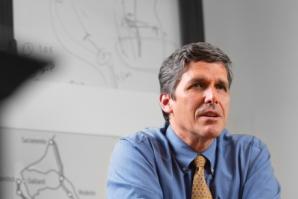For 15 years, the California High-Speed Rail Authority and its backers have discussed, planned, studied and lobbied for the kind of fast trains seen elsewhere around the world.
Now, with taxpayer authorization for $9 billion in state bonds, billions more in federal funding and the launch of a new campaign to attract private sector money, the rail project could start construction by late next year.
And if you can believe it, that’s even more complicated than it sounds.
The clock is ticking for construction of two segments of the proposed system, which ultimately would connect San Francisco and Los Angeles with 220 mph trains and eventually extend to Sacramento and San Diego. The first sections built would run 120 miles from Bakersfield to south of Madera, and detailed engineering and environmental work is wrapping up to allow for contracts to be completed in 2012. Backers say the work will be a major economic engine, creating the equivalent of 600,000 full-time construction jobs and acting as a catalyst for downtown redevelopment and smart growth in city centers along its route while reducing traffic congestion as the state’s population grows.
But with specifics come criticism, so the rail authority and its contractors are addressing concerns about the location and route, along with the oft-repeated complaints about the cost and wisdom of a system with an estimated construction price of $43 billion for the initial phase. At the same time, they’re developing business and funding plans, looking at options for how much of the system must be built before trains can start running, and pushing forward with plans for the next sections that must be built to complete the first phase of the system by 2020.
Complicating things even more is the shifting political and budgetary landscape, both in Sacramento and Washington. President Barack Obama has backed high-speed rail in a big way, proposing $53 billion in high-speed rail spending over the next six years, including $8 billion in next year’s budget. But the proposal faces GOP opposition in Congress, and Obama stands for re-election in 2012. Closer to home, the state’s budget crisis will play out over the next several months, and it’s unclear how a hiring freeze and other budgetary moves by Gov. Jerry Brown and the Legislature will affect high-speed rail.
“We have been at this for quite some time, and we are moving into the true implementation of this program now,” says Dan Leavitt, deputy director of the authority. “It’s going to be a big, important year for high-speed rail in California.”
The road to this point has been long and twisting. The project that Brown will have to consider as part of his 2011-2012 budget began in 1981 during the administration of … Gov. Jerry Brown. Talks then about working with Japanese partners on a Southern California high-speed rail corridor evolved over the next decade or so. Lynn Schenk, a member of Brown’s administration, went on to serve in Congress and introduced the 1994 bill establishing five high-speed rail corridors in the U.S.
California’s Intercity High-Speed Rail Commission studied the issue for three years and reported in 1996 that such a system was feasible. The Legislature and Gov. Pete Wilson established the rail authority that same year.
Years of planning and positioning followed. Lawmakers approved a proposal in 2002 asking voters for nearly $10 billion in bonds for high-speed rail, but it got caught up in the state’s budget mess after the dot-com bust and electricity crisis and was held off the ballot. Gov. Arnold Schwarzenegger signed a revised version of the bond measure, including $9 billion for high-speed rail and $950 million for related transportation projects, and voters approved it as Proposition 1A in November 2008.
Obama was elected at the same time and included $8 billion for high-speed rail within the American Recovery and Reinvestment Act of 2009. California landed the biggest slice of that funding: A series of announcements in 2010 included awarding $2.25 billion to match an equal amount in state funding; $715 million on a 70/30 match; and up to $624 million that had originally been awarded to Wisconsin and Ohio but was reallocated when those states backed away from their high-speed rail plans. Last month, Florida’s new governor also turned down more than $2 billion in federal grants intended for high-speed rail between Orlando and Tampa, citing fears about overoptimistic ridership projections and cost overruns that would leave his state on the hook for billions more in spending. Brown said the Florida rail funding would be “more than welcome” in California, but as of press time the state had taken no formal action to secure it.
In all, more than $5 billion in federal and state funding was allocated for the project last year — roughly 20 times more than the rail authority spent in its first 13 years of operation, based on expenditures listed in a 2009 report to the Legislature.
That means a time of rapid change for the authority, which had about a half-dozen employees at the time voters approved the state bonds. Now there are 17 with around 20 more slots on the organizational chart still to be filled, assuming the state hiring freeze is lifted or waived. (“We are still looking at it, but at this time it does appear the freeze applies to the Authority,” Press Secretary Rachel Wall said in an email shortly after Brown’s office announced the move in mid-February.)
In addition, nearly 500 full-time consultants are at work, from program management contractor Parsons Brinckerhoff Inc. — operating under a seven-year agreement valued in authority documents at $199 million — and a slew of regional engineering and environmental contractors to financial specialists, legal advisers and even a team developing video simulations of high-speed rail travel.
Work is moving forward on several simultaneous tracks, Leavitt says. The federal reinvestment grant requires that the Central Valley segments between Madera and Bakersfield be completed by the end of 2017, with construction starting next year. The schedule demands that detailed environmental reports be finished this year to allow time for contract proposals and land acquisition.
“You can’t just draw a line and be done,” says Tom Tracy, a regional manager for Parsons Brinckerhoff who is overseeing work from Fresno to Palmdale. “Last spring we sent biologists and specialists looking at things like vernal pools marching their way from Fresno down to Bakersfield.” Consultants from URS Corp. in Roseville also looked at issues such as whether proposed routes would cut across agricultural land or slice through expensive irrigation equipment or holding tanks for livestock manure that would be difficult to relocate. Their findings were reviewed and used to fine-tune some details of the route alternatives, then brought back to the authority. The reports must be completed in time for review and approval so construction can start on schedule. “2012, that’s the immovable object,” he says.
At the same time, work is proceeding to submit a required funding plan to the Legislature early in October. A revised business plan is due by Jan. 1, but it must be ready in advance to allow for public comment, so a draft for review also has to be ready by Oct. 1. Neither one of those documents can be completed without some decisions on the “initial operable segment” for the high-speed system; the announcement that the Central Valley segments would be built first led some pundits and politicians to deride it as “the train to nowhere,” but trains wouldn’t start running until more track was built. The rail authority’s board is expected to review proposals in March or April for just how big that initial section should be.
Among the most important efforts to the long-term prospects of high-speed rail is a move to attract interest from private companies. The authority took a formal step in February by inviting “expressions of interest” in any phase of the project, from construction of the first tracks to financing, supplying equipment and running and maintaining the system.
To be sure, it’s pretty early to be cutting private sector deals before the first shovel of dirt is turned. “We need to have more public funds before we can attract private sector support,” Leavitt says.
But it’s not too early to talk. Global companies active in high-speed rail around the world have been in touch. They include Siemens Industry Inc., which has a major factory in Sacramento to build light-rail cars and supplies the Velaro high-speed trains operating in Spain, France, Germany, China and elsewhere around the world.
“Siemens has met with (California rail officials) to share its experiences with public-private partnerships around the world and discussed possible structures and scenarios for California,” says Kate Eby, director of marketing communications for Siemens’ mobility division. “The Velaro is the type of train we’d like to bring to America.” Siemens will respond to the rail authority’s request and, if it were chosen as a supplier, would likely build equipment for the California system in Sacramento, she says. “Based on the quantities that are being discussed for California, it would present a significant boost to the local economy.”
Critics, including some of the congressional representatives who will vote on the next phase of high-speed rail funding, have accused backers of a pork-barrel rush to start construction because it’s harder to cut off the cash once steel is in the ground.
But plans for California high-speed rail are built on the notion of a public-private partnership with no operating subsidies. And no private company is likely to put its cash on the line if it doubts the project will be completed, says David Kutrosky, managing director of the Capitol Corridor Joint Powers Authority, which oversees commuter trains between San Jose and the Sierra foothills. The Capitol Corridor service would feed high-speed rail at San Jose and Sacramento and is in line for about $60 million from the Prop. 1A bonds for added service and improvements.
“The No. 1 challenge for them … and for every high-speed rail and intercity rail system out there is getting commitment of federal funding,” he says. “If (private companies) don’t see any commitment, there’s no reason for them to throw money in there. They’re not interested in subsidizing high-speed rail; they’re interested in turning a profit.”
Leavitt hopes the public and the politicians can look past immediate concerns about cost and think of high-speed rail as the kind of transportation infrastructure that can reshape the state, much as the Interstate highway system changed transportation, land use and economic growth starting in the 1950s. “This is a very important project for the sustainability of California’s future,” he says. “We believe our system will help cities throughout the state develop in a manner that reduces dependency on the automobile.” With demographers estimating that California’s population will reach 50 million by 2032, the state will have to add transportation capacity, he says, and while all the strategies to do so are expensive, high-speed rail can do so for less than adding new highway lanes or airports and without exacerbating sprawl.
Recommended For You

The Conductor
The California High-Speed Rail Authority replaced an engineer with a political operative to lead the nation’s biggest public works project. Jeff Morales instantly charmed his opponents but made technical decisions that placed high-speed rail at the mercy of the courts. Can Morales save his runaway train?

The Price of Progress
San Joaquin farmers protest bullet train
City dwellers driving past the expansive cotton fields and scattered farmhouses along Highway 43 to Corcoran might get the feeling they’ve left California. A haze of dust, bugs and little particles of cow dung blanket the road between Fresno and Bakersfield. Even on a nice day, wiping debris from a car windshield begins to feel futile.



